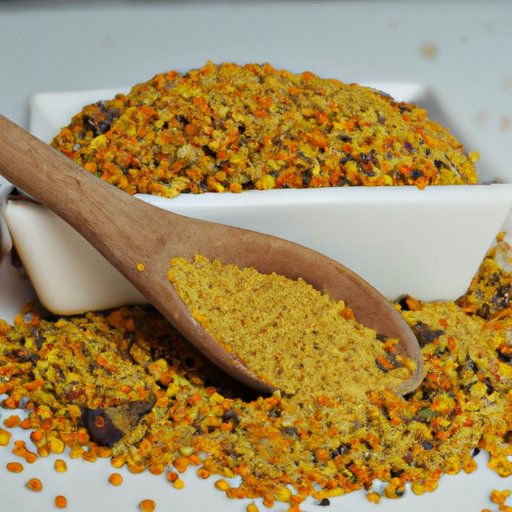Introduction
Bee pollen is a nutrient-rich superfood that has been used in traditional medicine for centuries. It contains a variety of beneficial compounds that can help support overall health and wellness. In this article, we’ll explore the benefits of eating bee pollen, the different varieties available, tips for incorporating it into your diet, its nutritional value, and some delicious recipes featuring bee pollen as an ingredient.
What is Bee Pollen?
Bee pollen is a powdery substance that is created by bees when they collect nectar from flowers. It is composed of tiny granules that are packed with essential vitamins, minerals, proteins, and fatty acids. Bee pollen is sometimes referred to as “nature’s multivitamin” due to its high nutrient content.

Types of Bee Pollen and How to Choose the Right One
There are several different varieties of bee pollen available on the market. Depending on the type of flower the bees collect nectar from, the color and flavor of the bee pollen will vary. For example, goldenrod bee pollen has a sweet, nutty flavor and light yellow color, while clover bee pollen has a mild, floral taste and greenish hue.
When choosing a bee pollen, it’s important to consider factors such as origin, processing method, and quality. Make sure to look for organic, non-GMO bee pollen that has been harvested and processed sustainably. Additionally, be sure to read labels to make sure the bee pollen you’re buying does not contain any additives or fillers.

Tips for Incorporating Bee Pollen into Your Diet
Bee pollen can easily be incorporated into your diet in a variety of ways. It can be sprinkled onto cereals, salads, smoothies, and other dishes for a boost of nutrition. Additionally, bee pollen can be added to beverages like tea and coffee for a subtle nutty flavor.
When adding bee pollen to meals and snacks, start with small amounts and gradually increase until you find the amount that works best for you. It’s also important to note that bee pollen should never be heated or cooked, as this will destroy its beneficial enzymes and nutrients.

Nutritional Value of Bee Pollen
Bee pollen is a powerhouse of nutrition and offers a variety of health benefits. According to a study published in the International Journal of Molecular Sciences, bee pollen is rich in vitamins, minerals, proteins, and fatty acids, which all work together to support optimal health and wellbeing.
Vitamins and minerals found in bee pollen include vitamin A, B-complex vitamins, vitamin C, calcium, magnesium, selenium, iron, and zinc. Additionally, bee pollen contains all of the essential amino acids needed for protein synthesis.
Bee pollen is also high in antioxidants, which help protect the body from damage caused by free radicals. A study published in the journal Evidence-Based Complementary and Alternative Medicine found that bee pollen has antibacterial, antifungal, and antiviral properties, making it an effective natural remedy for a variety of ailments.
Recipes Featuring Bee Pollen as an Ingredient
Now that you know more about the benefits of eating bee pollen and how to incorporate it into your diet, here are some delicious recipes featuring bee pollen as an ingredient.
Breakfast Recipes with Bee Pollen
Start your day off right with these nutritious breakfast recipes featuring bee pollen:
- Banana Oat Smoothie Bowl with Bee Pollen
- Vanilla Chia Pudding with Coconut and Bee Pollen
- Overnight Oats with Nuts and Bee Pollen
Lunch and Dinner Recipes with Bee Pollen
These savory lunch and dinner recipes are perfect for incorporating bee pollen into your daily meals:
- Kale Salad with Quinoa and Bee Pollen
- Stir-Fried Vegetables with Cashews and Bee Pollen
- Veggie Burgers with Avocado and Bee Pollen
Dessert Recipes with Bee Pollen
Satisfy your sweet tooth with these tasty desserts featuring bee pollen:
- Chocolate Fudge Brownies with Bee Pollen
- Blueberry Cheesecake with Bee Pollen
- Honey Yogurt Parfait with Bee Pollen
Conclusion
Bee pollen is a nutrient-rich superfood that has been used in traditional medicine for centuries. It contains a variety of beneficial compounds that can help support overall health and wellness. In this article, we explored the benefits of eating bee pollen, the different varieties available, tips for incorporating it into your diet, its nutritional value, and some delicious recipes featuring bee pollen as an ingredient. When choosing bee pollen, make sure to look for organic, non-GMO bee pollen that has been harvested and processed sustainably. Additionally, be sure to start with small amounts and gradually increase until you find the amount that works best for you.
By incorporating bee pollen into your diet, you can enjoy a variety of health benefits including improved immunity, increased energy levels, and better digestion. With the right bee pollen and some creativity, you can enjoy delicious meals and snacks that are packed with nutrition.
(Note: Is this article not meeting your expectations? Do you have knowledge or insights to share? Unlock new opportunities and expand your reach by joining our authors team. Click Registration to join us and share your expertise with our readers.)
